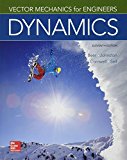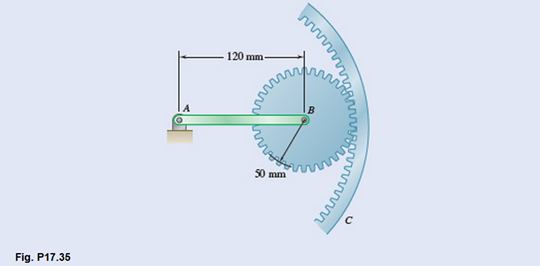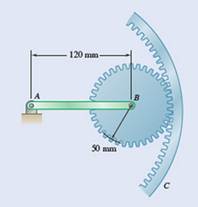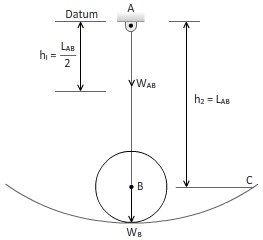
Concept explainers
The 1.5-kg uniform slender bar AB is connected to the 3-kggear B that meshes with the stationary outer gear C. The centroidal radius of gyration of gear B is 30 mm. Knowing that the system is released from rest in the position shown, determine (a) the angular velocity of the bar as it passes through the vertical position, (b) the corresponding angular velocity of gear B.

i.
Calculate the angular velocity of the bar when the bar is a vertical position.
Answer to Problem 17.35P
Angular velocity of the bar AB is
Explanation of Solution
Given:
Bar AB is connected to gear B which meshes with outer gear C. System is released from the rest.

Mass of bar AB,
Mass of gear B,
The radius of gyration of gear B,
The radius of gear B,
Length of Bar AB,
Concept used:
Energy conservation principle
Calculation:
Initial Position: the system is at rest

Kinetic energy,
Potential energy,
Final position: the bar is a vertical position

Moment of inertia of bar AB,
Moment of inertia of gear B,
But,
Kinetic energy,
Potential energy,
By energy conservation principle;
Conclusion:
Thus, the angular velocity of rod AB can be calculated by the energy conservation principle by considering the initial and final condition of the system.
ii.
Calculate the angular velocity of gear B.
Answer to Problem 17.35P
Angular velocity of gear B is
Explanation of Solution
Given:
Mass of bar AB,
Mass of gear B,
The radius of gyration of gear B,
The radius of gear B,
Length of Bar AB,
Concept used:
Energy conservation principle
Calculation:
Considering the value calculated in sub-part (i);
We know that,
Conclusion:
Thus, the corresponding angular velocity of gear B can be calculated by simple calculations.
Want to see more full solutions like this?
Chapter 17 Solutions
Package: Vector Mechanics For Engineers: Dynamics With 1 Semester Connect Access Card
- Each of the gears A and B has a mass of 675 g and a radius of gyration of 40 mm, while gear C has a mass of 3.6 kg and a radius of gyration of 100 mm. Assume that kinetic friction in the bearings of gears A, B C produces couples of constant magnitude 0.15 N.m, 0.15 N.m, 0.3 N.m, respectively. Knowing that the initial angular velocity of gear C is 2000 rpm, determine the time required for the system to come to rest.arrow_forwardAn experimental Fresnel-lens solar-energy concentrator can rotate about the horizontal axis AB that passes through its mass center G. It is supported at A and B by a steel framework that can rotate about the vertical y axis. The concentrator has a mass of 30 Mg, a radius of gyration of 12 m about its axis of symmetry CD, and a radius of gyration of 10 m about any transverse axis through G. Knowing that the angular velocities w1 and w2 have constant magnitudes equal to 0.20 rad/s and 0.25 rad/s, respectively, determine for the position 0= 60° (a) the forces exerted on the concentrator at A and B, (b)the couple M2k applied to the concentrator at that instant.arrow_forwardA 6-lb homogeneous disk of radius 3 in. spins as shown at the constant rate w1 = 60 rad/s. The disk is supported by the fork-ended rod AB , which is welded to the vertical shaft CBD The system is at rest when a couple M0 is applied as shown to the shaft for 3 s and then removed. Knowing that the maximum angular velocity reached by the shaft is 18 rad/s, determine (a) the couple M0) the dynamic reactions at C and D after the couple has been removed.arrow_forward
- The 10-in.-radius brake drum is attached to a larger flywheel which is not shown. The total mass moment of inertia of the flywheel and drum is 22 lb ⋅ ft ⋅ s 2 and the coefficient of kinetic friction between the drum and the brake shoe is 0.41. Knowing that the initial angular velocity is 255 rpm clockwise, determine the force which must be exerted by the hydraulic cylinder at point B if the system is to stop in 85 revolutions. DO NOT ROUND OFF IN THE SOLUTION. ROUND OFF ONLY THE FINAL ANSWERarrow_forwardTwo uniform cylinders, each of mass m = 6 kg and radius r = 125 mm, are connected by a belt as shown. Knowing that at the instant shown the angular velocity of cylinder A is 30 rad/s counterclockwise, determine (a) the time required for the angular velocity of cylinder A to be reduced to 5 rad/s, (b) the tension in the portion of belt connecting the two cylinders.arrow_forwardA 1200-kg satellite designed to study the sun has an angular velocity of w0 = (0.050 rad/s)i + (0.075 rad/s)k when two small jets are activated at A and B in a direction parallel to the y axis. Knowing that the coordinate axes are principal centroidal axes, that the radii of gyration of the satellite are and that each jet produces a 50-N thrust, determine (a ) the required operating time of each jet if the angular velocity of the satellite is to be reduced to zero, (b ) the resulting change in the velocity of the mass center G.arrow_forward
 Elements Of ElectromagneticsMechanical EngineeringISBN:9780190698614Author:Sadiku, Matthew N. O.Publisher:Oxford University Press
Elements Of ElectromagneticsMechanical EngineeringISBN:9780190698614Author:Sadiku, Matthew N. O.Publisher:Oxford University Press Mechanics of Materials (10th Edition)Mechanical EngineeringISBN:9780134319650Author:Russell C. HibbelerPublisher:PEARSON
Mechanics of Materials (10th Edition)Mechanical EngineeringISBN:9780134319650Author:Russell C. HibbelerPublisher:PEARSON Thermodynamics: An Engineering ApproachMechanical EngineeringISBN:9781259822674Author:Yunus A. Cengel Dr., Michael A. BolesPublisher:McGraw-Hill Education
Thermodynamics: An Engineering ApproachMechanical EngineeringISBN:9781259822674Author:Yunus A. Cengel Dr., Michael A. BolesPublisher:McGraw-Hill Education Control Systems EngineeringMechanical EngineeringISBN:9781118170519Author:Norman S. NisePublisher:WILEY
Control Systems EngineeringMechanical EngineeringISBN:9781118170519Author:Norman S. NisePublisher:WILEY Mechanics of Materials (MindTap Course List)Mechanical EngineeringISBN:9781337093347Author:Barry J. Goodno, James M. GerePublisher:Cengage Learning
Mechanics of Materials (MindTap Course List)Mechanical EngineeringISBN:9781337093347Author:Barry J. Goodno, James M. GerePublisher:Cengage Learning Engineering Mechanics: StaticsMechanical EngineeringISBN:9781118807330Author:James L. Meriam, L. G. Kraige, J. N. BoltonPublisher:WILEY
Engineering Mechanics: StaticsMechanical EngineeringISBN:9781118807330Author:James L. Meriam, L. G. Kraige, J. N. BoltonPublisher:WILEY





